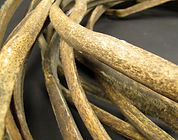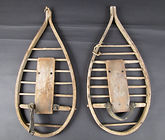The Jim and Vanita Oelschlager
Native American Ethnographic Collection
"Connecting Objects to their People: From the Arctic to Arizona"
Arctic / Subarctic: Land and People
The vast arctic cultural region spans over 5000 miles across four countries, the United States, Russia, Canada and Greenland. Native groups include Yupik, Aleutians, Inuit (Eskimo), and others who are related linguistically and share similar environment, living along the coast or in river valleys. The Yupik, Aleuts and Inuit, all share a similar material culture, although important variation exits among regional groups. The peoples’ lifestyles are a direct result of their ability to develop strategies to live in a harsh environment.
The cold climate supports little vegetation and most inhabitants rely on hunting, fishing and gathering in both the Arctic and Subarctic regions, covering much of Northwestern Canada and Alaska. The traditional Arctic foods include marine mammals, such as whales, and seals that were hunted in kayaks. Fish were caught in traps. The coastal tribes also hunted inland for large animals such as caribou, muskox and polar bear. During the summer months berries, tubers, and grasses supplemented their low carbohydrate-high fat and protein diets. Arctic peoples also relied heavily on walrus, seals, and whales to provide raw material for clothing, tools, oil and other domestic needs. Those who lived in river valleys trapped migrating fish and depended more on hunting large land animals such as caribou.
The cultural region spans the non-coastal regions of Alaska and most of Canada. The climate features short summers and long harsh winters. There are numerous different ecological zones ranging from coniferous forests, plateaus, prairies, and high mountain regions. Edible vegetation is sparse but they gathered a variety of berries and grasses in summer. Subarctic inhabitants still rely heavily on fishing and hunting as a way of life. Lakes and rivers contain fish and attract waterfowl. Land mammals such as elk, caribou, and moose are still hunted for food. Traditionally their hides were used for clothing, and shelter, the bones, hooves, and antlers for tools and ceremonial objects.






